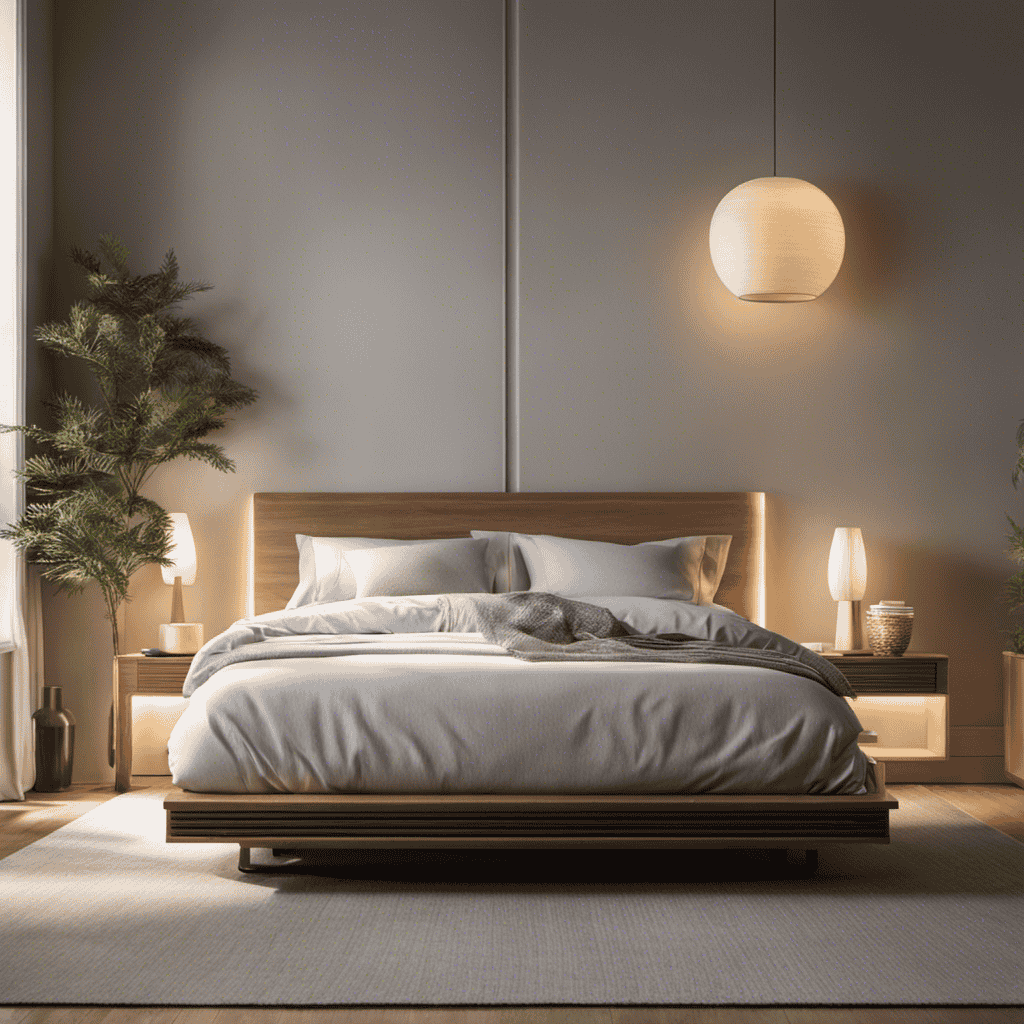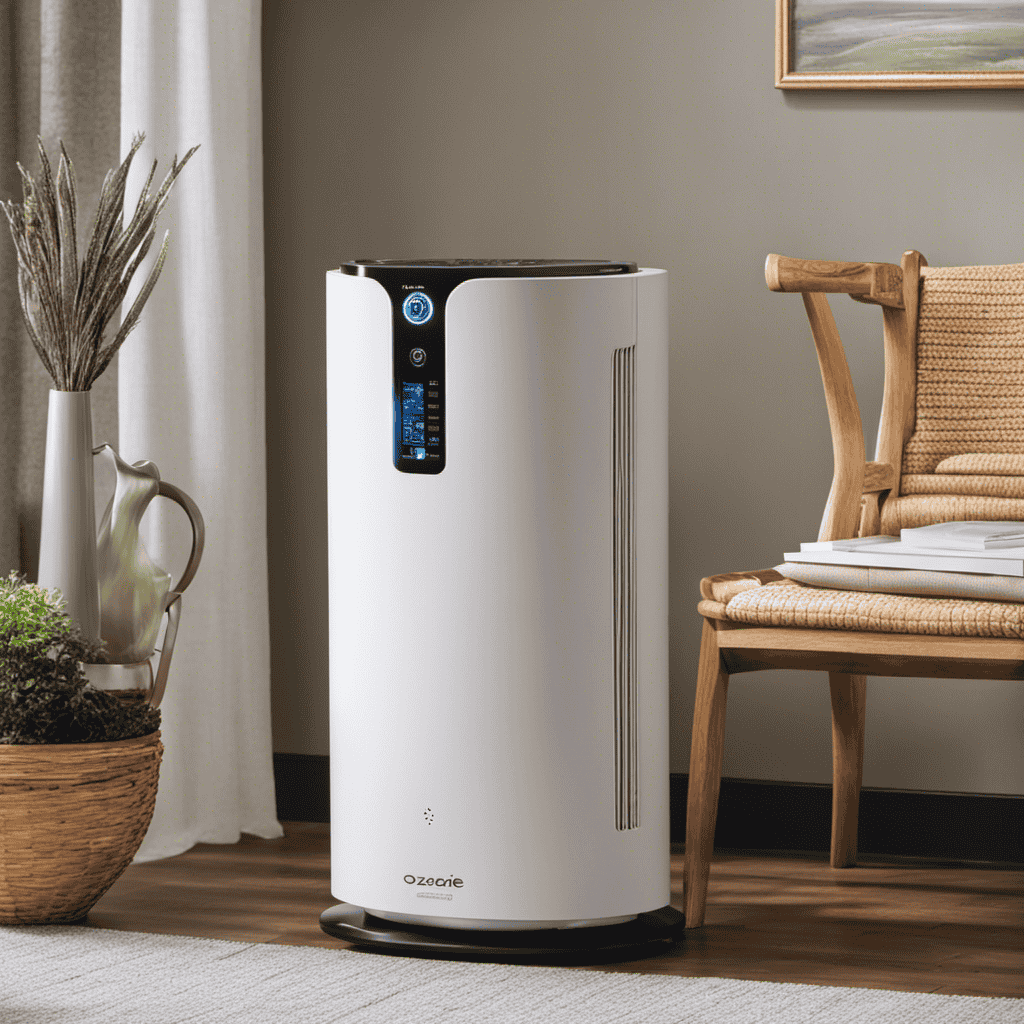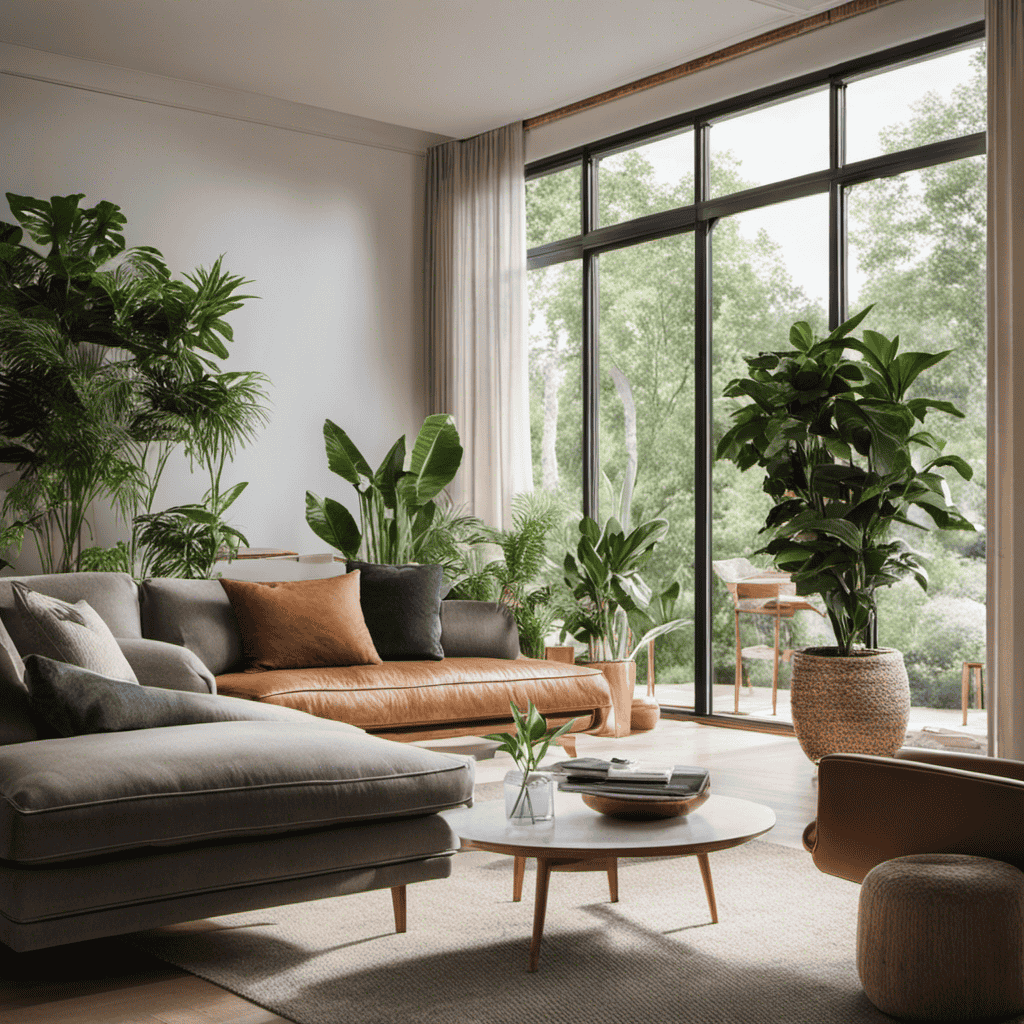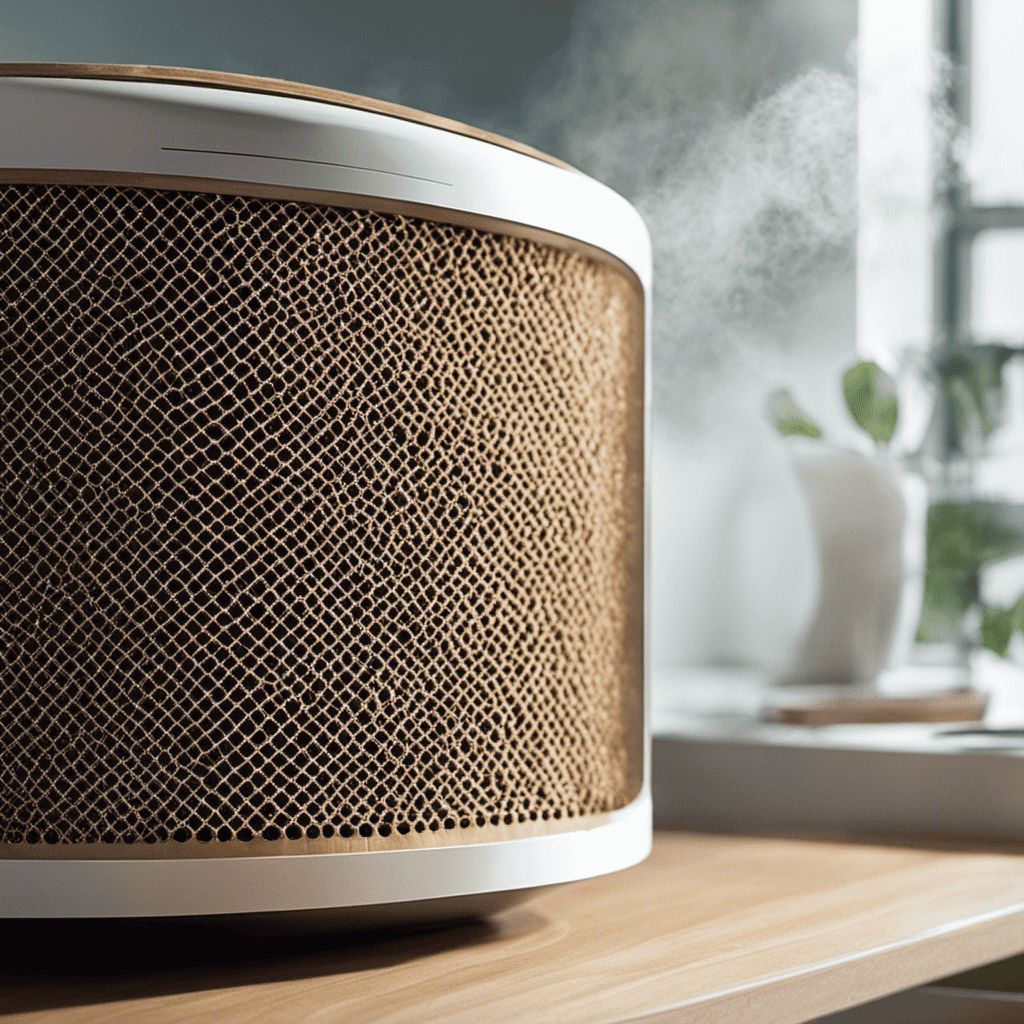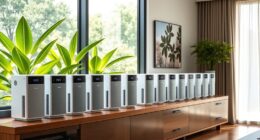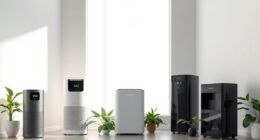When I inhale deeply, I can’t help but ponder: how exactly does an air purifier work? Every breath we take fills our lungs with unseen pollutants, turning them into a warzone.
In this article, I will shed light on the science behind air quality and the remarkable benefits an air purifier can bring. From tackling common indoor pollutants to soothing allergies and removing stubborn odors, we will explore the effectiveness of these devices and the importance of maintaining them.
Let’s dive into the world of clean air and discover the transformative power of air purifiers.
Key Takeaways
- Air purifiers effectively remove indoor air pollutants, such as dust, pet dander, tobacco smoke, VOCs, and mold spores, to maintain good air quality and reduce health risks.
- Prolonged exposure to pollutants can lead to respiratory diseases, allergies, and cancer, but air purifiers can help mitigate these risks by capturing and filtering out harmful particles.
- Individuals with respiratory conditions like asthma or allergies can benefit greatly from air purifiers, as they trap allergens and irritants, providing relief from common symptoms and improving overall well-being.
- Air purifiers equipped with HEPA filters can capture and trap airborne viruses and bacteria, improving overall respiratory health.
Understanding Air Quality
You should understand that air quality refers to the level of pollutants and contaminants present in the air you breathe. Indoor air pollutants are substances that originate from various sources within buildings, such as dust, pet dander, tobacco smoke, volatile organic compounds (VOCs), and mold spores. These pollutants can have harmful effects on human health, ranging from mild irritation of the eyes, nose, and throat to more severe respiratory issues and allergies.
Research has shown that exposure to indoor air pollutants can lead to both short-term and long-term health problems. Short-term effects may include headaches, dizziness, fatigue, and irritation of the respiratory system. Long-term exposure to indoor air pollutants has been linked to the development of chronic respiratory diseases, such as asthma and chronic obstructive pulmonary disease (COPD), as well as an increased risk of heart disease and lung cancer.
Understanding the harmful effects of indoor air pollutants is crucial in recognizing the importance of maintaining good air quality in our homes and workplaces. By using air purifiers, we can effectively remove these pollutants from the air, reducing our exposure and minimizing the associated health risks. Air purifiers work by employing various filtration technologies, such as high-efficiency particulate air (HEPA) filters, activated carbon filters, and ultraviolet (UV) light, to capture and neutralize indoor air pollutants.
Common Indoor Air Pollutants
As a researcher in the field of air quality, I’ve come across numerous studies highlighting the harmful effects of pollutants found in indoor environments. These pollutants, ranging from volatile organic compounds (VOCs) to fine particulate matter, have been linked to respiratory problems, cardiac issues, and even neurological disorders.
Therefore, understanding the efficiency of air purifiers in removing these pollutants becomes crucial in ensuring a healthy indoor environment.
Harmful Effects of Pollutants
The harmful effects of pollutants can be reduced with the use of an air purifier. Here are four key reasons why an air purifier is essential in combating the negative impacts of pollutants:
-
Pollutant sources: Air purifiers effectively remove pollutants from various sources such as tobacco smoke, pet dander, and volatile organic compounds (VOCs) released from household products. By targeting these sources, air purifiers help to improve indoor air quality.
-
Long-term health effects: Prolonged exposure to pollutants can lead to severe health issues like respiratory diseases, allergies, and even cancer. Air purifiers help to mitigate these risks by capturing and filtering out harmful particles, ensuring cleaner and healthier air to breathe.
-
Reduced respiratory symptoms: Individuals with respiratory conditions like asthma or allergies can benefit greatly from air purifiers. These devices trap allergens and irritants, providing relief from common symptoms such as coughing, sneezing, and wheezing.
-
Enhanced overall well-being: Breathing clean air can have a positive impact on our overall well-being. Improved air quality can result in better sleep, increased productivity, and reduced stress levels.
Air Purifier Efficiency
Air purifiers can effectively reduce the harmful effects of pollutants by efficiently capturing and filtering out harmful particles. When considering air purifier efficiency, two important factors to consider are noise levels and energy consumption.
Noise levels of air purifiers are measured in decibels (dB) and can vary depending on the model and settings. It is important to choose an air purifier with low noise levels to ensure a peaceful environment.
Energy consumption is another key aspect to consider. Look for air purifiers that are energy-efficient to minimize electricity usage and save on utility bills.
By selecting an air purifier with low noise levels and energy consumption, you can optimize the performance of the purifier while minimizing any negative impact on your living space.
Now let’s explore the health benefits of clean air.
Health Benefits of Clean Air
Clean air has a significant impact on our respiratory function, improving lung health and overall well-being. Studies have shown that exposure to clean air can lead to a decrease in respiratory symptoms such as coughing, wheezing, and shortness of breath.
Additionally, clean air plays a crucial role in reducing allergy symptoms by removing airborne allergens such as pollen, dust mites, and pet dander, which can trigger allergic reactions in susceptible individuals.
Improved Respiratory Function
Using an air purifier can help you breathe easier and reduce respiratory issues. Here are four ways an air purifier promotes improved lung health and provides relief from respiratory conditions:
-
Removal of airborne pollutants: Air purifiers effectively capture and eliminate common pollutants such as dust, pollen, pet dander, and mold spores. This reduces the risk of respiratory irritation and allergic reactions.
-
Filtration of harmful gases: Some air purifiers feature activated carbon filters that can absorb harmful gases like volatile organic compounds (VOCs) and odors. This helps improve indoor air quality and minimize respiratory discomfort.
-
Reduction of airborne viruses and bacteria: Air purifiers equipped with HEPA filters can capture and trap tiny particles, including airborne viruses and bacteria. This helps prevent the spread of respiratory infections and improves overall respiratory health.
-
Control of indoor humidity levels: Certain air purifiers come with built-in humidifiers or dehumidifiers. Maintaining optimal humidity levels can alleviate respiratory conditions like asthma and allergies.
Investing in an air purifier can significantly contribute to improved lung health and relief from various respiratory conditions.
Allergy Symptom Reduction
After discussing the improved respiratory function that air purifiers offer, let’s now delve into their effectiveness in reducing allergy symptoms.
Allergies can be triggered by various factors, including pollen, dust mites, pet dander, and mold spores. Air purifiers equipped with high-efficiency particulate air (HEPA) filters are designed to capture and remove these allergens from the air. The filters have a fine mesh that traps particles as small as 0.3 microns, effectively reducing the presence of pollen and other airborne allergens in the indoor environment.
Studies have shown that using air purifiers with HEPA filters can significantly alleviate allergy symptoms and improve overall quality of life. By controlling the levels of pollen in the air, individuals can experience much-needed allergy relief and enjoy a more comfortable living space.
How Air Purifiers Work
To understand how an air purifier helps, you should know that it works by filtering out pollutants and improving indoor air quality. Air purifiers are equipped with advanced technology that allows them to effectively remove harmful particles from the air.
Here are four key ways in which air purifiers benefit us:
-
Particle Filtration: Air purifiers use filters to capture and trap particles such as dust, pollen, pet dander, and mold spores. These filters have a high efficiency in removing even the smallest particles, significantly reducing their presence in the air we breathe.
-
Chemical Neutralization: Some air purifiers are equipped with activated carbon filters or other technologies that can remove or neutralize harmful chemicals and odors. These filters are particularly effective in eliminating volatile organic compounds (VOCs) and unpleasant smells.
-
Microbial Elimination: Air purifiers with UV-C light technology can destroy bacteria, viruses, and other microorganisms that may be present in the air. This helps to reduce the risk of respiratory infections and other illnesses caused by airborne pathogens.
-
Allergen Reduction: By filtering out allergens, air purifiers can provide relief to individuals suffering from allergies or asthma. Removing allergens from the air can help alleviate symptoms such as sneezing, coughing, and congestion.
Types of Air Purifiers
When it comes to choosing an air purifier, two important factors to consider are filter effectiveness and suitability for allergies.
To determine the filter effectiveness, one can compare the Clean Air Delivery Rate (CADR) of different purifiers, which indicates how efficiently they remove particles from the air.
Additionally, for those with allergies, selecting a purifier with a high-efficiency particulate air (HEPA) filter is crucial. This type of filter can capture even the smallest allergens, such as pollen, pet dander, and dust mites.
Filter Effectiveness Comparison
The filter effectiveness of an air purifier can be compared to determine its efficiency. In conducting a comparison analysis of different air purifiers, it is crucial to consider the filter technology used. Here are four key factors to evaluate:
-
Filter Efficiency: Look for purifiers with high-efficiency particulate air (HEPA) filters, capable of capturing particles as small as 0.3 microns.
-
Air Flow Rate: Assess the purifier’s CADR (Clean Air Delivery Rate), which measures the volume of clean air produced per minute. A higher CADR indicates faster purification.
-
Filter Lifespan: Consider the lifespan of the filter and the cost of replacement. A longer-lasting filter can save you money in the long run.
-
Filter Maintenance: Check if the filter requires regular cleaning or replacement. Some purifiers have washable filters, reducing maintenance costs.
Best Purifier for Allergies
One of the best purifiers for allergies is equipped with a HEPA filter that captures tiny particles. HEPA stands for High Efficiency Particulate Air and it is a type of filter that is capable of capturing 99.97% of particles as small as 0.3 microns. This makes it highly effective in removing common allergens such as pollen, pet dander, dust mites, and mold spores from the air.
When looking for the best purifier options, there are a few purifier features to consider. These include the CADR (Clean Air Delivery Rate), which indicates how quickly the purifier can clean the air in a specific room size, and the noise level, as some purifiers can be quite loud. Additionally, the size of the purifier and the filter replacement frequency are important factors to consider.
In the next section, we will discuss how to choose the right air purifier for your needs.
Choosing the Right Air Purifier for Your Needs
To choose the right air purifier for your needs, you should consider factors such as room size, filtration technology, and noise level. Here are four important features to consider when comparing air purifiers:
-
Room Size: The first thing to consider is the size of the room where you plan to use the air purifier. Different models are designed to handle different room sizes, so it’s important to choose one that is appropriate for your space. Oversized or undersized purifiers may not effectively clean the air.
-
Filtration Technology: Another crucial factor is the type of filtration technology used by the air purifier. HEPA (High-Efficiency Particulate Air) filters are highly effective in removing small particles such as dust, pollen, and pet dander. Some models also incorporate activated carbon filters to remove odors and harmful gases.
-
Noise Level: Consider the noise level of the air purifier, especially if you plan to use it in a bedroom or office. Look for models that have a low decibel rating to ensure a quiet operation.
-
Cost Comparison: Lastly, compare the cost of different air purifiers. Consider not only the upfront cost but also the long-term cost of replacement filters and energy consumption.
By carefully considering these factors, you can choose the right air purifier that best meets your needs.
Now let’s delve into the role of filters in air purifiers.
The Role of Filters in Air Purifiers
When choosing an air purifier, you should consider the role of filters and how they can improve your indoor air quality. Filters are an essential component of air purifier technology, as they trap and remove pollutants from the air. By effectively capturing particles such as dust, pollen, pet dander, and mold spores, filters help to create a cleaner and healthier environment for you and your family.
To understand the importance of filters in air purifiers, let’s take a closer look at the different types of filters commonly used:
| Filter Type | Description | Efficiency |
|---|---|---|
| HEPA Filter | High-efficiency particulate air (HEPA) filters are highly effective | Up to 99.97% |
| Carbon Filter | Carbon filters are effective at removing odors and chemical pollutants | Up to 90% |
| Pre-Filter | Pre-filters capture large particles, prolonging the life of HEPA filter | Size-dependent |
HEPA filters are the most common and efficient type, capable of removing up to 99.97% of airborne particles as small as 0.3 microns. Carbon filters are effective at removing odors and chemical pollutants, while pre-filters act as the first line of defense, capturing larger particles and extending the lifespan of the HEPA filter.
By incorporating these advanced filter technologies, air purifiers can significantly improve indoor air quality, providing numerous benefits, including:
- Reducing allergens and asthma triggers
- Removing harmful pollutants and toxins
- Eliminating unpleasant odors
- Creating a cleaner and healthier living environment
- Improving overall respiratory health
Investing in an air purifier with effective filters is a wise decision, as it can greatly contribute to the well-being of you and your loved ones. Don’t compromise on the quality of your indoor air – choose an air purifier with advanced filter technology to enjoy the benefits of clean air.
Maintenance and Care for Air Purifiers
Regularly cleaning and replacing the filters in your air purifier ensures optimal performance and keeps the air in your home clean and fresh. As a homeowner, it is important to understand the maintenance tips and troubleshooting tips to ensure your air purifier continues to function effectively. Here are four key points to consider:
-
Clean or replace pre-filters: Pre-filters capture larger particles like dust and pet hair. Regularly cleaning or replacing them prevents clogging and ensures proper airflow.
-
Clean or replace HEPA filters: HEPA (High-Efficiency Particulate Air) filters capture smaller particles such as pollen, mold spores, and pet dander. Cleaning or replacing these filters regularly ensures they can continue to trap these allergens effectively.
-
Monitor the activated carbon filter: Activated carbon filters help eliminate odors and volatile organic compounds (VOCs). Check and replace these filters when necessary to maintain their odor-absorbing properties.
-
Check the air purifier’s fan and motor: Over time, dust and debris can accumulate on the fan blades and motor, reducing their efficiency. Regularly cleaning these components helps maintain proper airflow and prevents overheating.
Air Purifiers for Allergies and Asthma
If you suffer from allergies or asthma, an air purifier can greatly improve the air quality in your home. Air purifiers are designed to remove airborne particles and allergens, such as pet dander and pollen, from the air. These devices work by using a combination of filtration technologies to trap and eliminate these irritants, allowing you to breathe easier and reduce the symptoms associated with allergies and asthma.
When it comes to air purifiers for pet dander, it is important to choose a model that has a high-efficiency particulate air (HEPA) filter. HEPA filters are capable of capturing tiny particles, including pet dander, that can trigger allergic reactions. Look for air purifiers with a high CADR (Clean Air Delivery Rate) for pet dander, as this indicates the device’s effectiveness in removing these allergens from the air.
For those who suffer from pollen allergies, air purifiers with HEPA filters are also recommended. Pollen particles are larger than pet dander, but HEPA filters can still effectively capture them. Additionally, some air purifiers come with specialized filters or pre-filters that can specifically target pollen.
In conclusion, air purifiers are an effective solution for allergies and asthma, as they can remove pet dander and pollen from the air. By investing in a high-quality air purifier, you can create a healthier indoor environment and alleviate the symptoms associated with these conditions.
Transitioning into the next section, let’s explore how air purifiers can also help with smoke and odor removal.
Air Purifiers for Smoke and Odor Removal
Transitioning into the next section, let’s explore how air purifiers can also assist with smoke and odor elimination.
When it comes to removing smoke and odor particles from the air, air purifiers have proven to be highly effective. Here are four key reasons why air purifiers are a valuable tool for eliminating smoke and odor:
-
Advanced filtration technology: Air purifiers are equipped with high-efficiency filters that can capture and trap tiny particles, including smoke and odor molecules. These filters are designed to effectively remove even the smallest particles, ensuring clean and fresh air.
-
Activated carbon filters: Many air purifiers feature activated carbon filters, which are specifically designed to absorb and neutralize odors. The porous structure of activated carbon allows it to effectively trap odor-causing molecules, leaving the air smelling clean and fresh.
-
Elimination of pet dander: Air purifiers equipped with HEPA filters are highly effective in removing pet dander from the air. Pet dander, a common allergen, can cause respiratory problems and allergic reactions. Air purifiers can help create a healthy and comfortable environment for pet owners.
-
Mold prevention: Air purifiers with HEPA filters can also help prevent the growth and spread of mold spores. Mold can release harmful toxins into the air, which can lead to respiratory issues and other health problems. By capturing and removing mold spores from the air, air purifiers contribute to a healthier living space.
In conclusion, air purifiers are not only beneficial for allergies and asthma, but they are also highly effective in eliminating smoke and odor particles. Their advanced filtration technology, activated carbon filters, and ability to remove pet dander and prevent mold growth make them an essential tool for maintaining a clean and healthy indoor environment.
Transitioning into the next section, let’s delve into evaluating the effectiveness of air purifiers.
Evaluating the Effectiveness of Air Purifiers
In the previous subtopic, we discussed how air purifiers can effectively remove smoke and odor particles from the air. Now, let’s delve into evaluating the effectiveness of air purifiers and explore the benefits of clean air.
When evaluating the effectiveness of air purifiers, several factors come into play. One important consideration is the Clean Air Delivery Rate (CADR), which measures how efficiently an air purifier can remove pollutants from the air. The higher the CADR, the more effective the purifier is at eliminating airborne contaminants.
Another factor to consider is the type of filtration system used in the air purifier. HEPA (High-Efficiency Particulate Air) filters are widely regarded as the gold standard for air purification. These filters can capture particles as small as 0.3 microns with an efficiency of 99.97%.
The benefits of clean air cannot be overstated. Breathing clean air can improve overall health and well-being by reducing the risk of respiratory illnesses, allergies, and asthma. Additionally, clean air promotes better sleep, enhances cognitive function, and boosts productivity.
Frequently Asked Questions
Are Air Purifiers Effective in Removing Pet Dander and Allergens From the Air?
Air purifiers are highly effective at reducing pet dander and allergens in the air. They work by filtering out these particles, trapping them in their filters, and preventing them from circulating in the room.
This is especially beneficial for allergy sufferers, as it helps to alleviate symptoms such as sneezing, coughing, and itchy eyes. By removing these airborne irritants, air purifiers create a cleaner and healthier indoor environment, improving overall air quality and providing relief for those with allergies.
Can Air Purifiers Help With Respiratory Conditions Such as COPD or Bronchitis?
Air purifiers are beneficial for respiratory health, particularly for individuals with conditions like COPD or bronchitis. They help by removing airborne pollutants such as dust, pollen, and pet dander, which can trigger asthma symptoms and exacerbate respiratory issues.
How Often Should the Filters in an Air Purifier Be Replaced?
I’ve found that the frequency of filter replacement in air purifiers depends on several factors. These factors include the type of filter and the air quality in your space. For example, if you live in an area with high levels of pollutants, you may need to replace the filters more frequently.
Generally, it is recommended to replace the filters every 6-12 months for optimal performance. This ensures that the air purifier continues to effectively remove pollutants from the air.
When it comes to removing smoke particles, air purifiers equipped with HEPA filters are highly effective. These filters can capture and remove smoke particles from the air, improving the overall air quality in your space.
Are There Any Health Risks Associated With Using an Air Purifier?
Health risks associated with using an air purifier are minimal. In fact, the benefits far outweigh any potential risks.
Air purifiers effectively remove pollutants, allergens, and irritants from the air, improving indoor air quality and reducing respiratory issues.
However, it is important to choose an air purifier that is appropriate for your specific needs and to properly maintain and clean the filters.
Regularly replacing filters and following manufacturer guidelines will help ensure optimal performance and minimize any potential health risks.
Can Air Purifiers Eliminate All Types of Indoor Pollutants, Including Volatile Organic Compounds (Vocs) and Mold Spores?
Air purifiers are a game-changer when it comes to improving indoor air quality. They are capable of eliminating various types of indoor pollutants, including volatile organic compounds (VOCs) and mold spores.
Unlike dehumidifiers, which only remove excess moisture, air purifiers actively filter out harmful particles from the air.
They are also a superior alternative to air fresheners, which simply mask odors without addressing the root cause.
With their scientific and data-driven approach, air purifiers provide a technical solution to create a healthier living environment.
Conclusion
In conclusion, it’s quite ironic that something as simple as an air purifier can have such a profound impact on our health and well-being. The scientific data clearly shows that these devices effectively remove common indoor air pollutants, providing us with cleaner and fresher air to breathe.
From reducing allergies and asthma symptoms to eliminating smoke and odors, air purifiers are a game-changer. So, if you want to experience the wonders of modern technology, invest in an air purifier and witness the transformation in your air quality.
